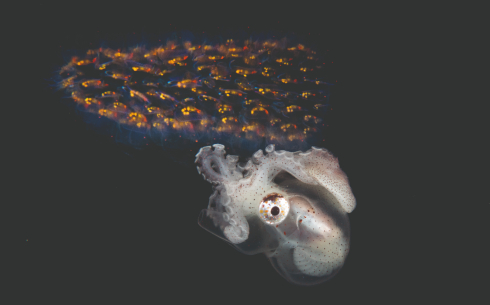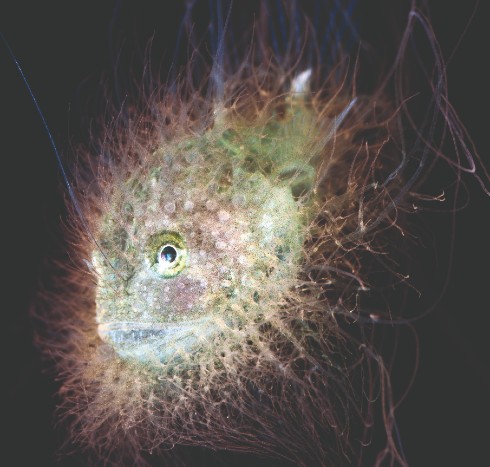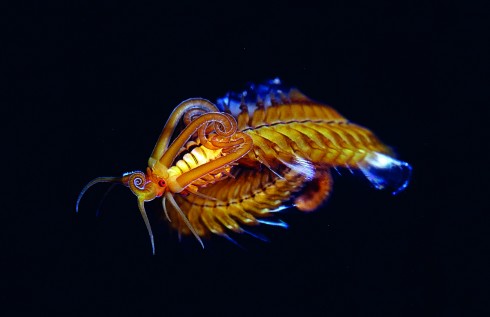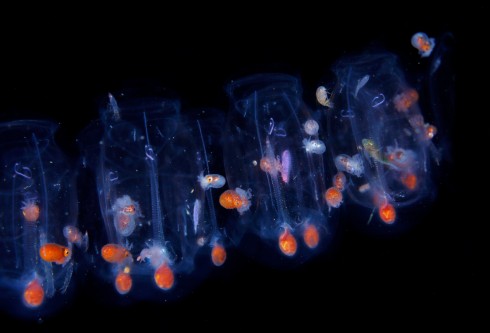Planktonia: diving at night for answers

Above: Paper nautilus and pyrosomes, photographed by Mike Bartick
In an exclusive extract from Planktonia, a new book exploring the remarkable species that float in our oceans, we meet the scientists and photographers working to capture these life forms on film
In 1817, French zoologist Georges Cuvier was the first to report the nightly vertical migration of plankton after witnessing it in a lake. In the late 1800s Austrian geologist Theodor Fuchs took net samples at various depths of the open ocean to show that planktonic crustaceans were moving from deep to surface waters as night came on. But no one realised how prevalent vertical oceanic migrations were.
During World War II, echo sounders on German U-boats in the North Atlantic found that the bottom of the ocean seemed to be moving up every night. After the war scientists comparing the mass of plankton and micronekton, such as lanternfishes, that they collected at different depths at night and in the day realised this was a biological phenomenon happening all over the ocean.
In Planktonia, Erich Hoyt explores this vast nightly movement of floating marine species, as well as the marine photographers who have helped us better understand these diverse and mysterious species. In this exclusive extract Hoyt looks at the evolution of ‘blackwater’ diving (diving in the open ocean at night) and how this pursuit has become a source of endless fascinating images for experts to analyse.
 Hairy goosefish (Lophiodes fimbriatus), photographed by Jeff Milisen
Hairy goosefish (Lophiodes fimbriatus), photographed by Jeff MilisenExtract from Planktonia by Erich Hoyt
After the Mediterranean and California, one of the favourite spots for early bluewater diving was off the Big Island of Hawaii, built up from the ocean floor by volcanoes with steep drop-offs. The depths offshore are 3,300 feet (1,000m) ranging up to 16,500 feet (5,000m). Imagine being in the open ocean with no land, no bottom, no reference point in sight. That’s what photographer Christopher Newbert wanted to experience in the early 1980s as he went diving in the deep waters off Kona, Hawaii. Then he decided to try something new — diving in open water at night.
Divers had gone night diving before, but never in the boundless black of the open ocean. Blackwater diving was born. “It was pretty wild,” says Jeff Milisen, a marine biologist and photographer who leads blackwater diving tours off Kona. “Newbert was diving alone, grabbing hold of a line, jumping out of his own boat far from shore, descending as deep as 150 feet (46m). He actually lost his boat a couple times. Fishermen reported picking him up the next morning. They would go and find his boat and then you’d hear that he’d done it again.” These days safety precautions for night diving are firmly in place.
“Newbert was the first one to publish photos and say ‘hey guys, there’s some fun stuff down here,’” adds Jeff. In 1984 more than 20 of Newbert’s night photos were published in his landmark book, Within a Rainbowed Sea, providing some of the first glimpses of the nocturnal activities of pelagic Hawaiian marine life. Way ahead of its time, the book became a must-read for anyone interested in the delicate patterns and gaudy colours of ocean found not only in the day, but also in the utter blackness of the night sea.
For the past six years Jeff has been taking advantage of every sleepless night to go diving in the deep waters off Oahu and, more recently, off the west side of the Big Island from the Kona coast. His photograph of a cookie cutter shark was his first publication and he was soon hooked. His current day job in aquaculture technology fits neatly with the night dives for Kona Honu Divers. Jeff admits, “I’ve never really wanted to spend time just looking through microscopes. Really, I was much more interested in seeing and interacting with animals. And taking photographs of them.”
Jeff understands how special Hawaii is, being in the middle of the vast Pacific Ocean with a high percentage of endemic species. “A few pioneer organisms have made the transoceanic journey, which means that a lot of ocean animals did not. But the few that made it here had an empty slate of niches into which they could evolve rapidly.
“So, while we are missing some species such as giant tridacna clams, groupers and cuttlefish, about 30% of the reef fishes and 30% of the molluscs here are unique. We do get big stuff here, swordfish, and huge shoals of squid that come in, including a bobtail squid that’s only found here. But how this translates into what we see in blackwater — let’s say it happens in ways we won’t fully understand until we’ve done a lot more diving.”
Every blackwater dive leads to more questions and, these days, sending photographs to scientists. In 2016 diver-photographer Mike Bartick started the Blackwater Photo Group on Facebook, which has become a place for divers to post pictures for fellow divers and scientists to speculate on and confirm identifications. Two of the most helpful for identifications have been fish scientist (ichthyologist) Bruce C Mundy, who worked for NOAA Fisheries in Hawaii for 33 years, and G David Johnson, a curator of fishes from the Smithsonian at the National Museum, Washington, DC. Most of what was known about planktonic larvae came through museums, where specimens have been fixed in formalin, stored in ethanol or an equivalent, after being collected in nets. These methods remove skin pigmentation and the delicate larval fish fins are sometimes mangled.
Ichthyologists have known for some time that the evolution of the larval forms followed paths separate from the evolution of the adults. The larvae evolve in response to survival in the planktonic realm of the open ocean and the associated vertical migrations; the adults of most species might settle into different habitats ranging from the deep-sea bottom to shallow water reefs. What then would be the value of having elaborate feathery fins? As larvae, these modified fins make them look larger and perhaps more like a dangerous, stinging jellyfish (siphonophore) than an edible morsel. Evolution by natural selection plays a role in the presence of these elaborate productions, although ichthyologists are still trying to figure out the precise purposes of the various ornaments in the larval stages. By the time the mature flounder settles on the seabed, the flamboyant fins are gone. The strategy for survival as an adult becomes camouflage (changing colour rapidly to match the bottom), along with two eyes on one side of its head and burying itself partly in the sand.
 Polychaete worm, photographed by Alexander Semenov
Polychaete worm, photographed by Alexander Semenov Spiral salp with resident paper nautilus fish, by Ryo Minemizu
Spiral salp with resident paper nautilus fish, by Ryo MinemizuRecently Jeff and his diving partner and wife, Sarah Matye, began photographing more and more of the tiny larvae and occasionally taking videos of them. As part of a collaborative study, they then collected individual specimens for DNA analysis so that more definitive identifications could be made and connections could be forged between larvae and adults. Capturing a single tiny individual is a slow process to avoid contamination and damage. Once collected, each individual was carefully catalogued and made ready for shipment to the lab for DNA analysis by David Johnson, Ai Nonaka and others at the Smithsonian, where it would be placed in a permanent collection for further research.
On their blackwater dives off Kona, Hawaii, Jeff and Sarah collected a total of 76 larval fish specimens for the analysis, each preserved in alcohol as a specimen, along with a tissue sample for genomic DNA extraction. This so-called DNA barcoding is a method that facilitates species identification. From the 76 specimens, 44 were identified to species or genus with a greater than 99% match, although nine were less than 99%. Thirteen could only be identified to family, one only to class. Two had no match in the database, indicating problems that need more research. Seven had a tissue sample that couldn’t be analysed due to various technical problems.
Three eel larvae in the study were the first to be identified to their species. One larval fish was the first of its genus to be identified.
They also captured unknown behaviour, such as the habit of fish larvae to go jelly riding, attaching themselves to gelatinous organisms, which is thought to provide protection — like travelling with a bodyguard or riding in a tank. Some carried tiny jellyfish to sting those that dared bother them.
In March 2021 Jeff Milisen, along with Dave Johnson and Ai Nonaka from the Smithsonian and Bruce C. Mundy from Ocean Research Explorations, summarised their work in the paper ‘Blackwater diving: an exciting window into the planktonic arena and its potential to enhance the quality of larval fish collections.’
Following publication, New York Times journalist Erik Olsen contacted Jeff and his co-authors to interview them, as well as various blackwater photography enthusiasts. The photos were splashed in vivid colour across several pages. The story echoed the conclusions of the scientific paper — that scientist as well as non-scientist divers and photographers could make substantial contributions to the study of larvae if they not only photograph it, but also, given the appropriate permits, if they collect some specimens for science. It was a call to action to go blackwater diving to advance our understanding of biodiversity in the ocean.
Erich Hoyt is a whale and dolphin (cetacean) researcher, conservationist, lecturer and author . He is currently a research fellow with Whale and Dolphin Conservation (WDC), in the UK.


